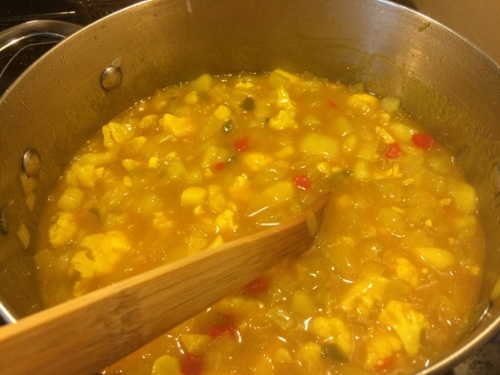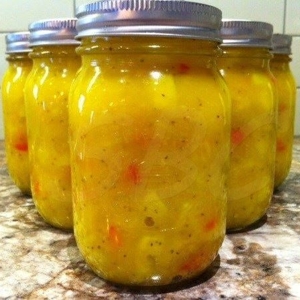We’ve been revisiting some venerable culinary traditions centred on the ancient art of Pickling. One that does not appear in my Mom’s 1930s Domestic Science Text Book is the now-ubiquitous Mustard Pickle. It’s easy to make and adds unique zing to summertime Burgers and Dogs!
 Classic Mustard Pickle: The final cook before bottling.
Classic Mustard Pickle: The final cook before bottling.
I hesitated at first to include this classic pickle recipe in the collection I’m posting this summer in honour of the Art of Pickling itself and in honour of the great practitioners of the Art – our Moms and Grandmas. That’s because, iconic as bright yellow Mustard Pickle may be, it is based largely on Cauliflower, rather than Cucumbers. And, when I was shopping yesterday, Cauliflower was still retailing at a hefty $4.99 a head. That’s nothing compared to the brief era of $8.00 Cauliflower we witnessed earlier this year, but it’s still crazy enough to make me think twice before buying it. But you just gotta post on Mustard Pickle! Mom said so.
What you’ll need…
2 qt. / 2 L finely chopped Cucumbers
1 large head Cauliflower, broken down into small florets
1 qt. / 1 L finely chopped White, Sweet or Spanisg Onion
1 coarsely chopped Sweet Red Pepper (optional)
1 cup / 250 ml Flour
2 cup / 500 ml Sugar
1 cup / 250 ml
1/3 cup / 85 ml Dry Mustard
1 tbsp. / 15 ml Turmeric
2 qt. / 2 L Cider Vinegar
2 qt. / 2 L Cold Water
What you’ll need to do…
This one is dirt easy, once you have all the chopping and separating-into-florets done!
Combine all the veggies in a large bowl, toss in the Salt and cover with the Cold Water. Let sit covered overnight. By morning, the Water will have become a Brine. In a large pot, bring the Brine and Veggies to the boil and hold there for a minute. Then remove from head. This we food service pros call Blanching, or par-cooking. Now, drain off the brine and discard.
In another large pot, combine the Mustard, Flour, Turmeric, Sugar and Vinegar. Stir until the mixture becomes smooth and saucy. Pour the Sauce over the Veggies in the first pot and stir gently until all the solids are coated with sauce and evenly distributed. Bring this pot almost to the boil and bottle the Pickles per the standard method described in the Heritage Pickles Intro.
.And that’s about it!
Leave these Pickles at least a month before tasting. They’ll last all Winter stored in a cool, dry place…
Enjoy!
~ Maggie J.

